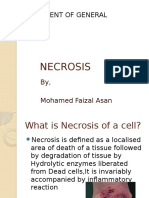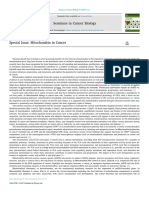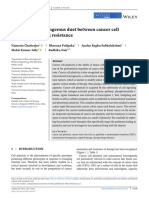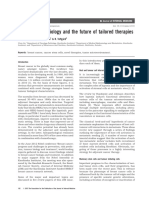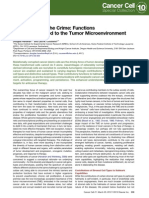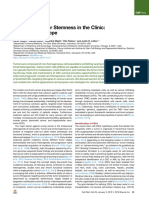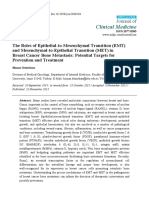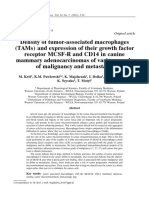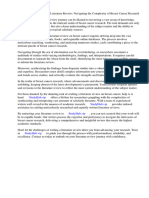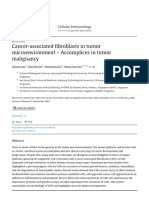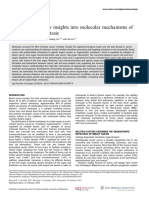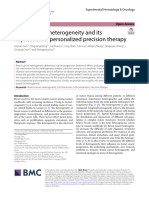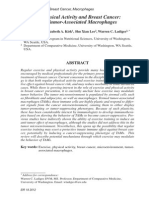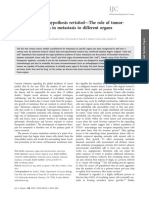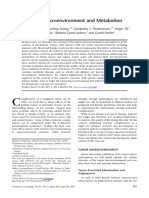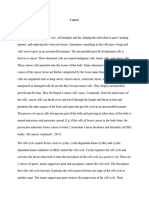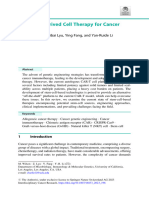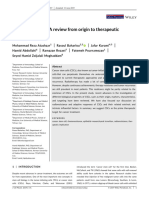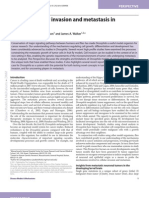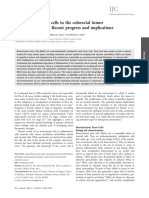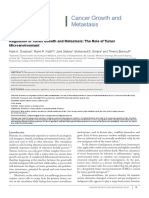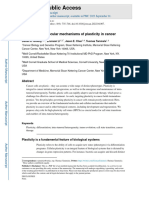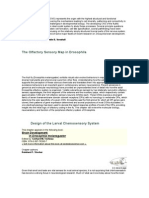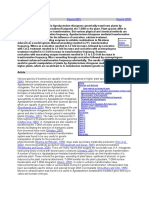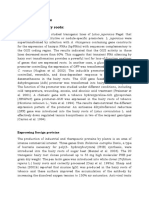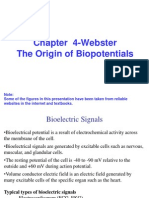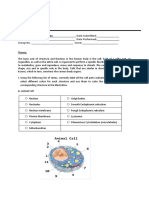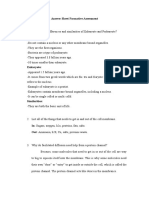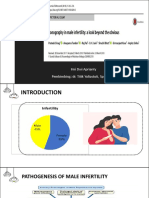Cancer Metasis
Cancer Metasis
Uploaded by
sandeshi1Copyright:
Available Formats
Cancer Metasis
Cancer Metasis
Uploaded by
sandeshi1Copyright
Available Formats
Share this document
Did you find this document useful?
Is this content inappropriate?
Copyright:
Available Formats
Cancer Metasis
Cancer Metasis
Uploaded by
sandeshi1Copyright:
Available Formats
Hindawi Publishing Corporation International Journal of Breast Cancer Volume 2012, Article ID 756257, 3 pages doi:10.
1155/2012/756257
Editorial The Inuence of the Cancer Microenvironment on the Process of Metastasis
Andra R. Frost,1 Douglas R. Hurst,1 Lalita A. Shevde,2 and Rajeev S. Samant2
1 Department 2 Department
of Pathology, University of Alabama at Birmingham, 1530 3rd Avenue South, Birmingham, AL 35294-1170, USA of Oncologic Sciences, Mitchell Cancer Institute, University of South Alabama, 1660 Springhill Avenue, Mobile, AL 36604, USA
Correspondence should be addressed to Andra R. Frost, afrost@uab.edu Received 26 February 2012; Accepted 26 February 2012 Copyright 2012 Andra R. Frost et al. This is an open access article distributed under the Creative Commons Attribution License, which permits unrestricted use, distribution, and reproduction in any medium, provided the original work is properly cited.
Metastasis of breast cancer is a multistep process that requires cancer cells to invade stroma at the primary site, gain access to vasculature, survive in the circulation, extravasate into the parenchyma of the secondary site, and survive and proliferate at the secondary site. During each of these steps, the microenvironment surrounding the cancer cells is believed to be an active participant. The cancer microenvironment also varies during the metastatic process. At the primary tumor in the breast, invasive cancer cells are surrounded by broblasts, extracellular matrix (ECM), cellular constituents of the vasculature, inammatory/immune cells, and adipose tissue. Metastasizing cancer cells are exposed to a completely dierent microenvironment within the circulatory system. The cancer microenvironment at the secondary site is, again, very dierent from the microenvironment of the breast and varies depending on the sites of metastasis. At the primary and metastatic sites, the interaction between tumor cells and their surrounding milieu is reciprocal; the tumor cells inuence the stroma and vice versa, ultimately fueling tumor progression. The papers in this issue discuss the dynamics of the interactions of tumor cells and their microenvironment, detailing how tumor cells manipulate their milieu and, conversely, how the reactive tumor microenvironment inuences tumor cell plasticity, invasion, metastasis, and cancer therapy. Z. I. Khamis et al. provide a thorough summary of the roles of the tumor stroma and tumor microenvironment in the various steps involved in the metastatic process, as well as in the development of breast cancer in their paper Active roles of tumor stroma in breast cancer metastasis. The authors
discuss research ndings related to the contribution of various constituents of the tumor microenvironment, including inammatory cells, broblasts, extracellular matrix, and blood vessels, in the metastatic process. They also include a discussion of the signaling pathways utilized by cancer cells to modify the stroma and ECM. This review serves as an excellent overview for this issue. Two papers in this issue discuss the cancer cells themselves and how characteristics or functions of the cancer cells inuence the tumor microenvironment. Just as the microenvironment signals to the cancer cells, the cancer cells alter the microenvironment to promote tumor progression and metastasis. J. E. Chu and A. L. Allan in their paper The role of cancer stem cells in the organ tropism of breast cancer metastasis: a mechanistic balance between the seed and the soil? have exhaustively summarized the role of the cancer stem cells in determining the organ tropism exhibited by breast cancer cells. Given the fact that metastasis is an inecient process, the authors make a compelling case for cancer stem cells to be the rare population that is equipped with the necessary armamentarium of traits to successfully metastasize. The paper summarizes the hierarchical role of cancer stem cells within the various subtypes of breast cancer and the phenotypic and functional signatures of breast cancer stem cells. It also puts into perspective the origin of cancer stem cells and their role in conditioning the premetastatic niche. The authors also provide a detailed analysis of the microenvironment of the various metastatic niches encountered by metastatic breast cancer cells, specically the bone, brain, lungs, liver, and lymph nodes. The paper
2 concludes with a stimulating discussion on the contribution of cancer stem cells to therapeutic resistance taking into account the interactions of the cancer stem cells with the microenvironment. The review by J. Alsarraj and K. W. Hunter, Bromodomain-containing protein 4: a dynamic regulator of breast cancer metastasis through modulation of the extracellular matrix, is focused on the activity of bromodomaincontaining protein 4 (BRD4) in breast cancer cells. BRD4 functions as an inherited susceptibility gene for breast cancer progression and metastasis and regulates the transcription of select genes through epigenetic mechanisms. Multiple ECM genes are regulated by BRD4 that may lead to changes in the overall structure of the surrounding environment or alter the cell-matrix interactions to promote breast cancer invasion and metastasis. The roles of estrogen receptor (ER) signaling and signaling through Toll-like receptors (TLR) in the crosstalk and interactions of breast cancer cells with the tumor microenvironment are the topics of another two papers in this issue. Hormones play a critical role in directing breast cancer progression. Specically, ER signaling is one of the critical and complex determinants of breast cancer metastasis. S. S. Roy and R. K. Vadlamudi have provided an integrated picture of this specic signaling in the paper Role of estrogen receptor signaling in breast cancer metastasis. They emphasize the importance of ER-coregulatory proteins and their misexpression in promoting metastasis of ER-positive breast cancer cells. They have discussed possible therapeutic targets to block ER-driven metastasis. Most signicantly, this paper brings to notice the importance of dening alternative signaling pathways. Specically, multiple signaling pathways in addition to estrogen signaling are involved in activating ERs. Hence, combination therapies using both endocrine and nonendocrine agents that block these dierent pathways may have better therapeutic eects and may delay metastasis. D. Bhattacharya and N. Yusuf discuss the data regarding TLR expression in breast cancer and its role in inammation and cell survival in the tumor microenvironment in Expression of Toll-like receptors on breast tumors: taking a Toll on tumor microenvironment. The immune system is intricately involved in the process of tumor progression and metastasis and can play key roles in both tumor promotion and tumor suppression. TLRs are critical for innate and adaptive immunity and are expressed on inammatory cells surrounding the tumor. Recent studies have identied many TLRs expressed by tumor cells that may promote growth and immune evasion. This has led to the emergence of TLR signaling as a potential target for the treatment of various tumors. One of the most common sites for the metastasis of breast cancer is to bone. In accordance with this, four papers focus on breast cancer metastasis to bone. B. Y. Reddy et al. put into perspective the role of the microenvironment of the bone in breast cancer metastasis in The microenvironmental eect in the progression, metastasis, and dormancy of breast cancer: a model system within bone marrow. The heterogeneous composition of the bone microenvironment not only facilitates the growth of breast cancer cells but also supports
International Journal of Breast Cancer and protects the tumor cells. There is a bidirectional crosstalk between the cells comprising the bone microenvironment and the metastatic breast cancer cells. While modulation of macrophage function can cause immune suppression, the release of inammatory cytokines by adipocytes can stimulate tumor cell invasion, and the expression of SDF-1 by the myobroblasts accelerates tumor cell growth. The contribution of mechanical stress in impacting tumor cell survival, elicitation of angiogenesis, and inuencing drug delivery is elegantly summarized. This paper also discusses the role of microenvironment-derived cytokines, chemokines, and miRNA in inducing epithelial-mesenchymal changes and inuencing cancer cell quiescence. D. M. Sosnoski et al. present their ndings on the inuence of metastases on the levels of a variety of cytokines and growth factors in the bone in their research article Changes in cytokines of the bone microenvironment during breast cancer metastasis. Using a xenograft model of breast cancer metastases to bone, they demonstrate that the presence of the breast cancer cells in bone changes the normal levels of specic cytokines. Cytokines are important for bone remodeling, hematopoietic processes, and homeostatic balance in the bone. Therefore, by altering cytokine levels in the bone, metastatic breast cancer manipulates the bone microenvironment. A complementary perspective on the dynamic dialogue between the stroma and the tumor cells, which impacts metastasis of tumor cells to bone, is provided by E. Bevilacqua et al. in RKIP suppresses breast cancer metastasis to the bone by regulating stroma-associated genes. This focuses on the metastasis suppressor, Raf Kinase Inhibitory Protein (RKIP), and its ability to inuence the tumor microenvironment in the bone. RKIP inhibits breast cancer invasion, intravasation, and bone metastasis via the induction of miRNA let-7, resulting in suppression of the chromatinremodeling factor HMGA2 and modulation of epithelial to mesenchymal plasticity. The use of a savvy, interdisciplinary approach involving expression arrays from breast cancer patients yielded a deeper understanding of key regulators of genes that form the bone metastasis signature of cancer cells, putting the spotlight on RKIP as a critical regulator of the tumor milieu and impacting the ability of tumor cells to establish bone metastases. The bone microenvironment is a fertile soil for metastasis with multiple regulatory molecules aecting growth. Accumulating evidence supports the notion that hedgehog signaling plays a role in breast cancer metastasis to bone. In The hedgehog pathway conditions the bone microenvironment for osteolytic metastasis of breast cancer, S. Das et al. discuss our current understanding of how the hedgehog signaling pathway alters the bone microenvironment to promote metastatic breast cancer growth. Hedgehog inhibitors may be a viable option for the treatment and/or prevention of breast cancer metastasis to bone. Finally, J. W. Rostas and D. L. Dyess have provided the surgeons perspective of current surgical management of breast cancer in Current operative management of breast cancer: an age of smaller resections and bigger cures. Consideration of the tumor microenvironment is an emerging frontier
International Journal of Breast Cancer in the treatment of breast cancer. The surgeons primary focus with breast-conserving surgery is obtaining tumorfree surgical margins, but there is a question as to whether residual stromal changes in the breast may aect local recurrence. The authors emphasize that surgical intervention is currently the best hope for denitive cure of breast cancer; however, advances in the treatment of breast cancer as a systemic disease are needed to facilitate long-term cures. Patient-specic molecular diagnosis and the development of targeted chemotherapeutic agents are future hopes for improved survival and will oer the surgeon an opportunity to be more focused and allow easier management of the disease. Andra R. Frost Douglas R. Hurst Lalita A. Shevde Rajeev S. Samant
You might also like
- Body Overhaul Slider Project Manual v1.8Document34 pagesBody Overhaul Slider Project Manual v1.8Jose Luis LeguiaNo ratings yet
- Necrosis - Gen. PathologyDocument16 pagesNecrosis - Gen. PathologyMohamed FaizalNo ratings yet
- Paper Cancer MamaDocument10 pagesPaper Cancer MamaMichelle HidroboNo ratings yet
- Mitocondria in CancerDocument3 pagesMitocondria in CancerTeoMartinNo ratings yet
- Tumor Microenvironment: Cellular, Metabolic and Immunologic InteractionsDocument171 pagesTumor Microenvironment: Cellular, Metabolic and Immunologic Interactionshiếu caoNo ratings yet
- Comp Sys Onco - 2023 - Chatterjee - Unraveling The Dangerous Duet Between Cancer Cell Plasticity and Drug ResistanceDocument15 pagesComp Sys Onco - 2023 - Chatterjee - Unraveling The Dangerous Duet Between Cancer Cell Plasticity and Drug ResistanceDevi RamadaniNo ratings yet
- Bergh 2013Document4 pagesBergh 2013bixagif369No ratings yet
- Accessories To The Crime Functions of Cells Recruited To The Tumor MicroenvironmentDocument14 pagesAccessories To The Crime Functions of Cells Recruited To The Tumor MicroenvironmentMariano PerezNo ratings yet
- Cancer Invasion and Metastasis - Molecular and Cellular Perspective 2013Document38 pagesCancer Invasion and Metastasis - Molecular and Cellular Perspective 2013Maria Elena MaldonadoNo ratings yet
- Lathia Et Al 2019: Targeting Cancer Stemness in The Clinic: From Hype To HopeDocument16 pagesLathia Et Al 2019: Targeting Cancer Stemness in The Clinic: From Hype To Hopesara.hrabovskaNo ratings yet
- TMP 2798Document19 pagesTMP 2798FrontiersNo ratings yet
- Spatial Biology of Cancer EvolutionDocument19 pagesSpatial Biology of Cancer Evolutionzhe zhNo ratings yet
- Mesothelin Promotes Epithelial-Tomesenchymal Transition and TumorigenicityDocument13 pagesMesothelin Promotes Epithelial-Tomesenchymal Transition and Tumorigenicitypaulo saNo ratings yet
- Density of Tumor Associated MacrophDocument8 pagesDensity of Tumor Associated MacrophPalloma PortoNo ratings yet
- Fphar 09 00259Document10 pagesFphar 09 00259leartaNo ratings yet
- Review2008 - Metastasisb Cancer CellDocument29 pagesReview2008 - Metastasisb Cancer CellHuynh Luong DoNo ratings yet
- Breast Cancer Stem Cells As Drivers of Tumor ChemoDocument25 pagesBreast Cancer Stem Cells As Drivers of Tumor ChemoKhaoua JamalNo ratings yet
- Literature Review Breast Cancer PDFDocument7 pagesLiterature Review Breast Cancer PDFaflsimgfs100% (1)
- Evolutionary Foundations For Cancer BiologyDocument16 pagesEvolutionary Foundations For Cancer BiologyDenish MikaNo ratings yet
- Cell Bio CriticDocument24 pagesCell Bio CriticRetchel Cadayong NavalesNo ratings yet
- MJZ 033Document10 pagesMJZ 033metrorespoNo ratings yet
- Fidler 2001Document14 pagesFidler 2001Claudia BrînzaNo ratings yet
- Stem CellsDocument16 pagesStem CellsdregopokeNo ratings yet
- Cancer-Associated Fibroblasts in Tumor Microenvironment - Accomplices in Tumor Malignancy - ScienceDirectDocument6 pagesCancer-Associated Fibroblasts in Tumor Microenvironment - Accomplices in Tumor Malignancy - ScienceDirectPedro MatosNo ratings yet
- Ijms 21 05207 v2Document20 pagesIjms 21 05207 v2Rina UlfaNo ratings yet
- Organo TropismDocument12 pagesOrgano TropismKL TongsonNo ratings yet
- Breast Cancer Heterogeneity and Its Implication in Precision MedecineDocument27 pagesBreast Cancer Heterogeneity and Its Implication in Precision Medecineevapruvost2No ratings yet
- Exosome-Mediated Metabolic Reprogramming: The Emerging Role in Tumor Microenvironment Remodeling and Its in Uence On Cancer ProgressionDocument13 pagesExosome-Mediated Metabolic Reprogramming: The Emerging Role in Tumor Microenvironment Remodeling and Its in Uence On Cancer ProgressionHossam El-basiounyNo ratings yet
- Riparian Ecosystems in Human CancersDocument8 pagesRiparian Ecosystems in Human CancerssgutierNo ratings yet
- SSRN 4877450Document12 pagesSSRN 4877450SonuNo ratings yet
- Ejerciio y Cancer de Mama 2012Document19 pagesEjerciio y Cancer de Mama 2012Edith TafurNo ratings yet
- Stampferetal 2013 SpringerDocument40 pagesStampferetal 2013 SpringerPilar AufrastoNo ratings yet
- Int Jurnal OncoDocument9 pagesInt Jurnal OncoWida MarianeNo ratings yet
- Understanding and Leveraging Phenotypic PlasticityDocument11 pagesUnderstanding and Leveraging Phenotypic Plasticitysneha.921530sharmaNo ratings yet
- Cancers 15 03942Document23 pagesCancers 15 03942Monique XyztNo ratings yet
- The Seed and Soil Hypothesis Revisited-The Role of Tumor-Stroma Interactions in Metastasis To Different OrgansDocument9 pagesThe Seed and Soil Hypothesis Revisited-The Role of Tumor-Stroma Interactions in Metastasis To Different OrgansClaudia BrînzaNo ratings yet
- The Stromal Genome Heterogeneity Between Breast and Prostate Tumors Revealed by A Comparative Transcriptomic AnalysisDocument11 pagesThe Stromal Genome Heterogeneity Between Breast and Prostate Tumors Revealed by A Comparative Transcriptomic AnalysishameedhaaNo ratings yet
- Chhabra & Weeraratna 2023Document30 pagesChhabra & Weeraratna 2023Javiera FerradaNo ratings yet
- Tumor Macroenvironment and Metabolism PDFDocument15 pagesTumor Macroenvironment and Metabolism PDFRio Auricknaga KintonoNo ratings yet
- Quality of Life Measurement in Bone Metastases A Literature ReviewDocument5 pagesQuality of Life Measurement in Bone Metastases A Literature ReviewiimytdcndNo ratings yet
- Cancer 55Document9 pagesCancer 55Bilal SaeedNo ratings yet
- Deciphering Breast Cancer - From Biology To The ClinicDocument21 pagesDeciphering Breast Cancer - From Biology To The ClinicMedia 05No ratings yet
- Literature Review On Cancer DiseaseDocument7 pagesLiterature Review On Cancer Diseaseafdtvztyf100% (1)
- Medsci 06 00031 PDFDocument113 pagesMedsci 06 00031 PDFCarolina VillalobosNo ratings yet
- Hallmarks of Cancer An OrganizingDocument4 pagesHallmarks of Cancer An OrganizingIna SimacheNo ratings yet
- 0005737713 1..23 ++Document23 pages0005737713 1..23 ++马三强No ratings yet
- Cancer Stem Cells: A Review From Origin To Therapeutic ImplicationsDocument9 pagesCancer Stem Cells: A Review From Origin To Therapeutic ImplicationsJoyatideb SinhaNo ratings yet
- Drosophila: Modeling Tumor Invasion and Metastasis inDocument9 pagesDrosophila: Modeling Tumor Invasion and Metastasis inFernando Lazzarotto EvaldtNo ratings yet
- Intl Journal of Cancer - 2012 - Hogan - Mesenchymal Stem Cells in The Colorectal Tumor Microenvironment Recent ProgressDocument7 pagesIntl Journal of Cancer - 2012 - Hogan - Mesenchymal Stem Cells in The Colorectal Tumor Microenvironment Recent ProgressEduardo BautistaNo ratings yet
- Jurnal NeoplasmaDocument10 pagesJurnal NeoplasmaFadhilah Asyifa DewantiNo ratings yet
- Cancer Stem CellsDocument14 pagesCancer Stem CellsShivani SinghNo ratings yet
- Mesenchymal Stem Cell Mediated Cancer Therapy CryovidaDocument8 pagesMesenchymal Stem Cell Mediated Cancer Therapy CryovidaJob MonobeNo ratings yet
- Main Journal Lorenc2020Document14 pagesMain Journal Lorenc2020Kevin CindarjoNo ratings yet
- Hallmarks of Cancer: The Next Generation: ReviewDocument29 pagesHallmarks of Cancer: The Next Generation: Review122307403No ratings yet
- Frontiers in Bioscience E4, 2502-2514, June 1, 2012Document13 pagesFrontiers in Bioscience E4, 2502-2514, June 1, 2012ginocolaciccoNo ratings yet
- Salvador 2016 PDFDocument11 pagesSalvador 2016 PDFbiancacampitelliNo ratings yet
- Tight Junctions and The Tumor MicroenvironmentDocument11 pagesTight Junctions and The Tumor MicroenvironmentbiancacampitelliNo ratings yet
- Nihms 1810343Document19 pagesNihms 1810343Devi RamadaniNo ratings yet
- Hallmarks of Cancer: The Next GenerationDocument6 pagesHallmarks of Cancer: The Next GenerationKaren Joy MariñasNo ratings yet
- Cancer y Celulas Madre 2022Document11 pagesCancer y Celulas Madre 2022Jose EdgarNo ratings yet
- Hallmark of CancerDocument14 pagesHallmark of CanceriinsabatiniNo ratings yet
- A Feedback Regulatory Loop Involving MicroRNA-9 and Nuclear Receptor TLX in Neural Stem Cell Fate DeterminationDocument17 pagesA Feedback Regulatory Loop Involving MicroRNA-9 and Nuclear Receptor TLX in Neural Stem Cell Fate Determinationsandeshi1No ratings yet
- Top Results Discussion Materials and Methods Supporting Information ReferencesDocument49 pagesTop Results Discussion Materials and Methods Supporting Information Referencessandeshi1No ratings yet
- The Central Nervous SystemDocument3 pagesThe Central Nervous Systemsandeshi1No ratings yet
- Neural Development in HumansDocument14 pagesNeural Development in Humanssandeshi1No ratings yet
- Tabacum As A Model System. Manual Wounding Resulted in 21% TransformationDocument7 pagesTabacum As A Model System. Manual Wounding Resulted in 21% Transformationsandeshi1No ratings yet
- Advantages of Hairy RootsDocument5 pagesAdvantages of Hairy Rootssandeshi1No ratings yet
- Ri PlasmidDocument5 pagesRi Plasmidsandeshi1No ratings yet
- Bio ElecDocument63 pagesBio ElecPiyush AroraNo ratings yet
- Unit-V Chapter 20. Breathing and Exchange of Gases: Important PointsDocument13 pagesUnit-V Chapter 20. Breathing and Exchange of Gases: Important PointsminaNo ratings yet
- AABB Primer of Blood AdministrationDocument112 pagesAABB Primer of Blood AdministrationMohamed ElmasryNo ratings yet
- ExcretionDocument14 pagesExcretionAuthor ClubNo ratings yet
- General Biology Q4 M3Document16 pagesGeneral Biology Q4 M3Delfin LeeNo ratings yet
- Cell The Fundamental Unit of LifeDocument54 pagesCell The Fundamental Unit of LifeAxyahh 99No ratings yet
- G9 - Lesson 1 Cardiovascular SystemDocument7 pagesG9 - Lesson 1 Cardiovascular SystemKhrean Kae SantiagoNo ratings yet
- NCM 107 SL (Care of Mother, Child, Adolescent) Ballard ScoringDocument7 pagesNCM 107 SL (Care of Mother, Child, Adolescent) Ballard ScoringclrssNo ratings yet
- Human Anatomy and Physiology W/ Human PathophysiologyDocument2 pagesHuman Anatomy and Physiology W/ Human PathophysiologyJuliana CostinianoNo ratings yet
- Principles of Designing Maxillofacial Prosthesis - Maxilary DefectsDocument96 pagesPrinciples of Designing Maxillofacial Prosthesis - Maxilary DefectsDr.Sathyabhama A.VNo ratings yet
- NucleusDocument2 pagesNucleuslinhNo ratings yet
- Exercise # 1 - The CellDocument4 pagesExercise # 1 - The CellMJMadlangbayanNo ratings yet
- Student Handbook 2020 2021Document108 pagesStudent Handbook 2020 2021kumari dissanayake100% (1)
- Histopath Transes 3Document3 pagesHistopath Transes 3Nico LokoNo ratings yet
- Nursing Clients With Hematologic DisordersDocument4 pagesNursing Clients With Hematologic DisordersLuna MarieNo ratings yet
- NUMC 101 Module 1 Cardiovascular System Blood Lab ExerciseDocument10 pagesNUMC 101 Module 1 Cardiovascular System Blood Lab ExerciseHannah Vannerie AlanguiNo ratings yet
- Dhruv Biology FinalDocument15 pagesDhruv Biology FinaldhruvlaltikarNo ratings yet
- Answer Sheet Formative AssessmentDocument4 pagesAnswer Sheet Formative Assessmentapi-328130455No ratings yet
- Instructions:: Narayana Group of SchoolsDocument12 pagesInstructions:: Narayana Group of SchoolsRafi MohammedNo ratings yet
- (Jurnal) Sonography in Male InfertilityDocument25 pages(Jurnal) Sonography in Male InfertilityIrni Dwi Aprianty IbrahimNo ratings yet
- BlooodDocument14 pagesBlooodMarija JurakovićNo ratings yet
- L041 - Laboratory Exercise No. 1B - Dautil JastineDocument2 pagesL041 - Laboratory Exercise No. 1B - Dautil JastineJastine Managbanag DautilNo ratings yet
- Class 8 Block Test Qs PaperDocument5 pagesClass 8 Block Test Qs PaperMiley StewartNo ratings yet
- Neurology of Visceral PainDocument2 pagesNeurology of Visceral PainprimzadeshaNo ratings yet
- Blood Plasma Fractionation ProcessDocument2 pagesBlood Plasma Fractionation ProcessAli Hussain100% (1)
- Course Syllabus - Hematology 2Document2 pagesCourse Syllabus - Hematology 2Fearless Angel100% (1)
- BIOS1155 Outline S1 2017Document19 pagesBIOS1155 Outline S1 2017JanaNo ratings yet
- Chapter 15 Student Version The Urinary System 2020.ppt (1402)Document20 pagesChapter 15 Student Version The Urinary System 2020.ppt (1402)S. MartinezNo ratings yet

